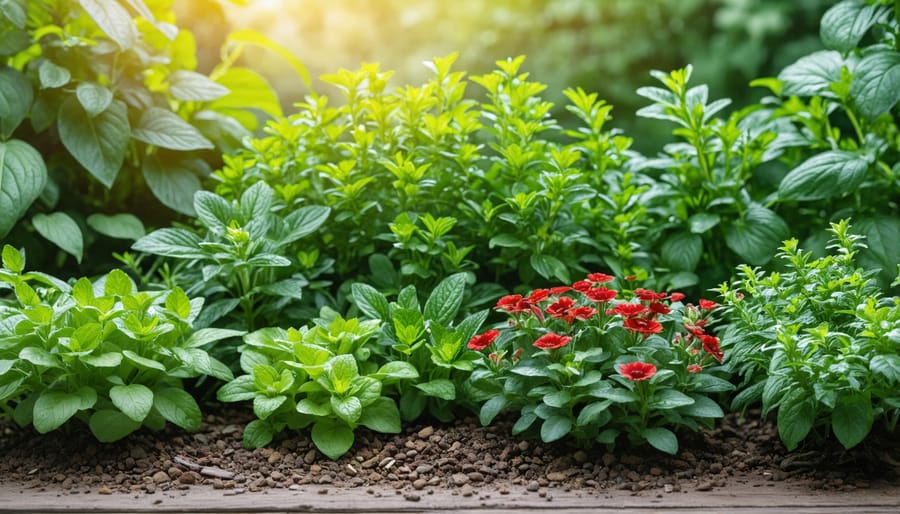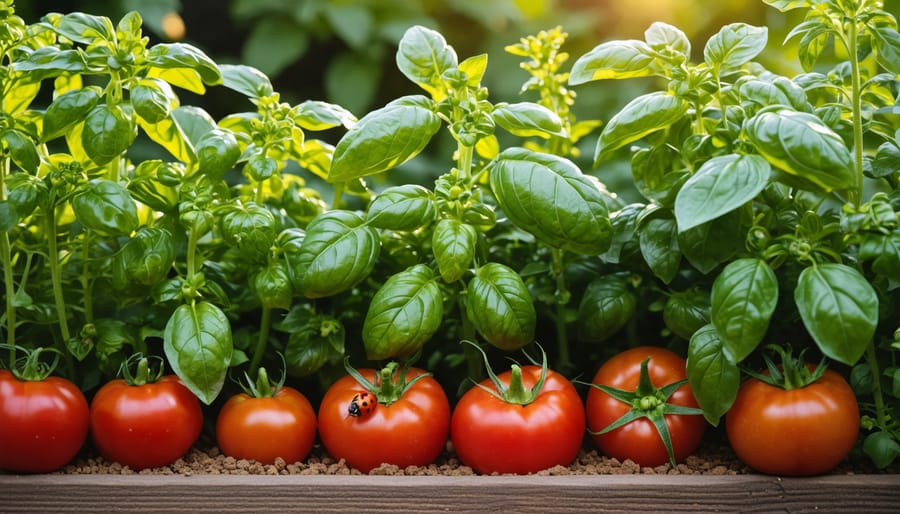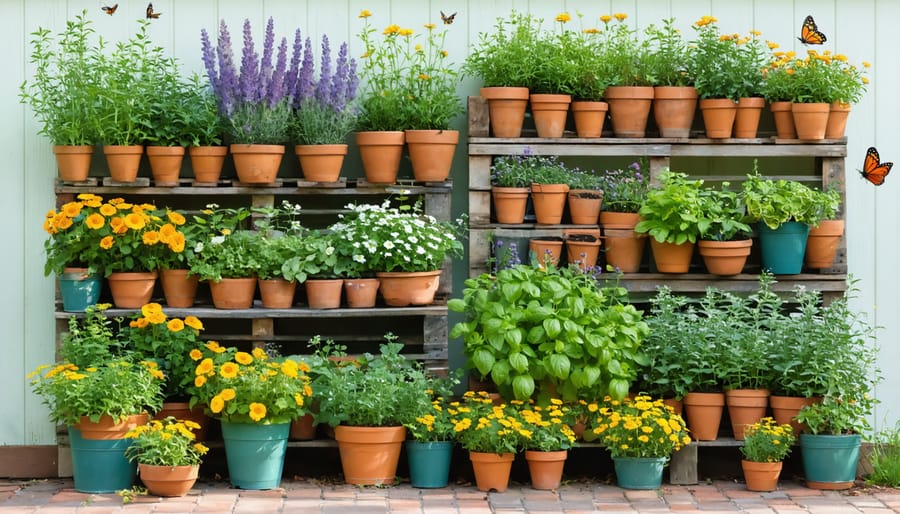Plant basil next to your tomatoes and oregano alongside peppers in your herb garden—you’ll notice fewer aphids within days and stronger plant growth within weeks. This isn’t gardening folklore; it’s biodiversity at work, and yes, it’s remarkably good for your herb garden.
When you mix different herb varieties instead of planting rows of single species, you’re creating a miniature ecosystem that naturally resists pests, improves soil nutrition, and often increases your harvest. I learned this after years of fighting spider mites in my monoculture mint patch, then watching them virtually disappear when I interplanted thyme and chives.
The question isn’t really whether biodiversity is good—research and countless gardeners’ experiences confirm it is—but rather how to harness it practically in your space. Different herbs have varying root depths, nutrient needs, and natural pest-repelling properties. Combining them strategically means your garden essentially takes care of itself better than any single-plant setup ever could.
Some gardeners worry that mixing herbs creates chaos or makes harvesting difficult, and there are situations where focused plantings make sense. But for most home gardeners, the tangible benefits of biodiversity—healthier plants, reduced pest problems, and better soil—far outweigh the minimal extra planning required. Let’s explore exactly what biodiversity does for your herb garden and how to implement it successfully.
What Biodiversity Actually Means in Your Herb Garden
When I first heard gardeners talking about biodiversity in their herb gardens, I’ll admit I thought they just meant planting lots of different herbs. Basil here, rosemary there, maybe some thyme in the corner. But biodiversity is actually so much more interesting than that, and understanding it completely changed how I approach my garden.
Think of biodiversity as the entire cast of characters in your garden’s story, not just the herbs themselves. Yes, having different herb varieties matters, but true biodiversity includes everything from the tiniest soil bacteria you can’t see to the bees buzzing around your lavender, the earthworms tunneling below, the ladybugs hunting aphids, and even the fungi forming networks around your plant roots.
Here’s a simple way to picture it: your herb garden isn’t just a collection of plants. It’s a living neighborhood where everyone has a role to play. The oregano attracts different pollinators than the cilantro does. The deep roots of your sage bring up nutrients that shallow-rooted parsley can use. Beneficial insects make homes in your dense thyme patches. Underground, countless microorganisms are breaking down organic matter and making nutrients available to your plants.
When gardeners talk about building biodiversity, they’re really talking about creating this thriving community. It’s about recognizing that your garden is healthiest when it supports many different forms of life, all interacting and supporting each other. The more diverse this community becomes, the more resilient and self-sustaining your herb garden can be. It’s nature’s original support system, and you’re simply the thoughtful host bringing everyone together.

The Natural Pest Control You Get for Free
Beneficial Insects That Call Diverse Herb Gardens Home
When you create a tapestry of different herbs in your garden, you’re essentially rolling out the welcome mat for nature’s pest control squad. Ladybugs, those charming spotted beetles we all love, flock to diverse herb gardens where they feast on aphids that might otherwise attack your basil and cilantro. I’ve watched a single ladybug devour dozens of aphids in just one afternoon near my dill plants.
Lacewings are another wonderful ally, with their delicate green bodies and golden eyes. They’re particularly drawn to gardens with flowering herbs like fennel and yarrow. Their larvae are voracious predators of soft-bodied pests.
Ground beetles, the unsung heroes working the night shift, patrol your soil surface eating slugs and caterpillars. They thrive in gardens with varied plantings that provide shelter and hunting grounds.
Hoverflies might look like bees, but these gentle flies are pollination powerhouses. Plant some sweet alyssum or chamomile among your culinary herbs, and you’ll see them darting between flowers. Their larvae also consume aphids, giving you double benefits.
Parasitic wasps, tiny and harmless to humans, lay their eggs in garden pests like tomato hornworms. The more plant diversity you offer, the more these beneficial insects stick around to protect your harvest naturally.

Real Garden Example: How Mixed Planting Solved My Aphid Problem
Last spring, my basil plants were under siege. Aphids covered nearly every stem, and I was ready to give up. Then my neighbor, an experienced gardener, suggested I try something different: instead of rows of single herbs, she encouraged me to scatter marigolds, nasturtiums, and various herbs together in one bed.
I was skeptical at first. Wouldn’t mixing everything create chaos? But within three weeks, I noticed something remarkable. Ladybugs appeared seemingly out of nowhere, feasting on the remaining aphids. The marigolds attracted hoverflies, whose larvae are aphid-eating machines. My basil not only recovered but thrived alongside its new companions.
This experience taught me that organic gardening methods work best when we mimic nature’s diversity. The mixed planting created a balanced ecosystem where beneficial insects naturally controlled pests. I harvested more basil that season than ever before, and I didn’t spray a single chemical. Now, I wouldn’t dream of planting any herb garden without intentionally including companion plants to support biodiversity.
Healthier Soil Without Extra Work
How Different Root Systems Work Together
Think of your herb garden like an apartment building where residents occupy different floors. Shallow-rooted herbs like basil, cilantro, and parsley work the top 6-8 inches of soil, absorbing nutrients and moisture near the surface. Meanwhile, deep-rooted herbs like rosemary, lavender, and fennel send their roots down 12-24 inches or more, mining minerals from lower soil layers.
This natural layering creates a healthier soil structure in several ways. The shallow roots prevent surface erosion and keep the top layer loose and aerated, while deep roots break up compacted subsoil and create channels that improve drainage. When deep roots bring up nutrients from below, those minerals eventually become available to shallow-rooted plants as leaves drop and decompose.
I learned this firsthand when I planted basil alongside rosemary. The basil thrived in the loose topsoil the rosemary’s woody roots had helped stabilize, and neither competed for the same resources. This complementary relationship means you can grow more herbs in less space without depleting your soil.

The Nitrogen-Fixing Herbs You Should Include
Want to boost your garden’s biodiversity while naturally enriching your soil? Leguminous herbs are your secret weapon. These remarkable plants form partnerships with beneficial bacteria that convert atmospheric nitrogen into a form your plants can use—essentially creating free fertilizer right in your garden bed.
Start with clover, particularly white Dutch clover. It makes an excellent living mulch between taller herbs and adds nitrogen while suppressing weeds. I’ve seen struggling basil plants perk up within weeks when interplanted with clover.
Fenugreek is another winner for herb gardens. This aromatic legume not only fixes nitrogen but also attracts beneficial insects. Plant it between rows of thyme or oregano for best results.
Don’t overlook alfalfa, which sends down deep roots to break up compacted soil while bringing nutrients to the surface. Though it grows taller than most culinary herbs, it works beautifully as a border plant.
The best part? You don’t need to harvest these nitrogen-fixers perfectly. Simply chop them back occasionally and let the clippings decompose in place. Those roots left in the soil release nitrogen as they break down, feeding your entire garden ecosystem. It’s nature’s own fertilizer system at work.
Better Harvests and Longer Growing Seasons
When you embrace biodiversity in your herb garden, you’re essentially creating a thriving ecosystem that works harder for you throughout the entire growing season. Let me share what I’ve learned from both personal experience and conversations with successful gardeners about how this translates into tangible benefits for your harvest.
First, diverse plantings mean you’ll have something to harvest almost year-round. While basil might dominate your summer harvests, chives emerge early in spring, and rosemary continues producing well into winter. When I spoke with master gardener Patricia Chen, she explained that her perennial herb gardens provide consistent yields because different herbs peak at different times. This staggered productivity means your kitchen always has fresh ingredients available.
Pollination rates dramatically improve when you grow multiple herb varieties. Bees and other beneficial insects attracted to flowering dill or oregano will also visit neighboring plants, improving overall garden health and seed production if you let some herbs flower. This increased pollinator activity creates a ripple effect of productivity across your entire garden space.
Disease resistance is another game-changer. In monoculture plantings, a single fungal infection or pest problem can devastate your entire crop. With biodiversity, problems rarely spread as effectively. The aromatic compounds from diverse herbs actually confuse pests, making it harder for them to locate their preferred host plants. I’ve noticed my sage stays healthier when planted near thyme and oregano compared to when I grew it alone.
Your soil benefits too, as different herbs have varying root depths and nutrient needs. Shallow-rooted parsley coexists beautifully with deep-rooted fennel, maximizing your garden’s productive capacity without competition.
The Disease Resistance Advantage
Think about what happens when you plant row after row of just basil, or dedicate an entire bed to only mint. It might look tidy and organized, but you’ve essentially laid out a buffet table for any disease that targets that specific plant. When disease strikes a monoculture garden, it spreads like wildfire because every plant is equally vulnerable and sitting conveniently close together.
I learned this lesson the hard way when downy mildew swept through my all-basil container garden one humid summer. Within days, I watched nearly every plant succumb to those telltale yellow leaves and fuzzy gray undersides. It was heartbreaking, and entirely preventable.
Here’s where biodiversity becomes your garden’s immune system. When you mix different herbs together, you create natural barriers that slow or stop disease spread. Picture it like this: if a pathogen jumps from one oregano plant to the next but encounters rosemary in between, it often can’t make the leap. Different plants have different susceptibilities, different leaf structures, and different chemical compositions that pathogens can’t easily navigate.
Master gardener Elena Rodriguez, who maintains a thriving community garden in Portland, puts it simply: “Diversity interrupts the disease highway. When I plant thyme next to cilantro next to parsley, diseases lose their direct route from victim to victim.”
This isn’t just theory. Gardens with mixed plantings consistently show fewer devastating disease outbreaks because pathogens encounter resistance at every turn, protecting your harvest naturally.
Creating Biodiversity in Your Herb Garden: Simple Steps
The Perfect Starter Mix for Biodiversity Beginners
Ready to start designing your herb garden for maximum biodiversity? Here’s my tried-and-true starter combination that works beautifully together.
Begin with basil as your centerpiece—it attracts beneficial pollinators and grows vigorously. Add parsley nearby; its umbrella-shaped flowers welcome predatory wasps that control aphids. Thyme makes an excellent ground cover, suppressing weeds while its tiny blooms feed small native bees. Cilantro is fantastic because it bolts quickly, providing continuous flowering that supports hoverflies, nature’s aphid controllers.
Include chives for their gorgeous purple pompom flowers that butterflies adore, and finally, oregano, which spreads nicely and offers late-season blooms when other plants are finishing up.
This combination works because you get staggered bloom times from spring through fall, different flower shapes that attract various pollinator species, and varied root depths that improve soil structure. The mix of upright, spreading, and compact growth habits creates habitat layers where beneficial insects can shelter. Plus, you’ll harvest fresh herbs all season while watching your garden buzz with life!
Adding Flowering Herbs for Maximum Benefit
One of the most rewarding ways to boost biodiversity in your herb garden is by selecting flowering herbs with staggered bloom times. Start your season with early bloomers like chives and cilantro, which flower in spring and attract the first emerging pollinators. As temperatures rise, lavender, thyme, and oregano take center stage through summer, providing crucial nectar when bees and butterflies are most active.
For late-season support, let your basil bolt and plant borage, which flowers well into autumn. I learned this from gardener Maria Gonzales, who noticed her pollinator population tripled after implementing succession planting. The key is allowing some herbs to complete their flowering cycle rather than constantly trimming them back. This simple approach creates a continuous buffet for beneficial insects while adding visual interest to your garden. You’ll find your entire garden ecosystem becomes more resilient as these diverse blooms support different pollinator species throughout the growing season.
Container Garden Biodiversity Tips
Don’t let limited space hold you back from creating a thriving ecosystem! Container gardens can be surprisingly biodiverse when you think creatively. Mix tall herbs like rosemary with trailing varieties such as thyme to maximize vertical space. I love clustering different-sized pots together—this creates microclimates that attract various beneficial insects.
Try combining herbs with different root depths in larger containers. Basil pairs beautifully with shallow-rooted chives, while deeper-rooted parsley can share space without competition. Add a small flowering herb like lavender or oregano to draw in pollinators.
Even balconies and windowsills can support small-space biodiversity. Include one container with native flowers alongside your herbs to provide habitat for local insects. Master gardener Elena Rodriguez suggests rotating your containers seasonally, allowing soil to rest while maintaining year-round diversity. Remember, every pot counts toward supporting local ecosystems!
When Too Much Variety Becomes a Problem
Let’s be honest—while biodiversity is generally wonderful, you can absolutely have too much of a good thing in your herb garden. I learned this the hard way when I enthusiastically crammed fifteen different herb varieties into a four-by-four raised bed. The result? A chaotic tangle where nobody thrived.
The main challenge with excessive variety is competition. When too many plants jostle for the same space, they battle for sunlight, water, and nutrients. Aggressive spreaders like mint can overtake gentler neighbors, while tall plants might shade out sun-loving basil. You might also find yourself overwhelmed with maintenance—different herbs have different watering needs, pruning schedules, and pest vulnerabilities.
I spoke with Martha Henderson, a master gardener with thirty years of experience, who wisely reminded me: “Biodiversity isn’t about quantity; it’s about balance. Three compatible varieties planted thoughtfully will outperform ten varieties crammed together.”
Here’s how to avoid these pitfalls while keeping biodiversity benefits. Start small with three to five complementary herbs that share similar growing conditions. Give each plant adequate space—check mature sizes before planting. Group herbs by water needs so you’re not overwatering Mediterranean varieties while trying to keep moisture-loving herbs happy. Consider vertical growing for vining herbs to maximize space without crowding.
Remember, successful biodiversity means creating a harmonious community, not a competitive jungle. Pay attention to how your plants interact, and don’t hesitate to remove or relocate struggling specimens. Sometimes less truly is more, especially when you’re still learning what works in your unique garden space.
So there you have it—biodiversity in your herb garden isn’t just good, it’s transformative. By welcoming a mix of varieties into your growing space, you’re creating a natural system that practically takes care of itself. Your plants will be healthier, pests will find fewer opportunities to cause trouble, and your soil will thank you with improved structure and fertility. Plus, you’ll enjoy a more abundant harvest and the simple pleasure of watching different herbs interact and thrive together.
This season, I encourage you to step outside your comfort zone and introduce at least two or three new herb varieties you’ve never grown before. Maybe it’s time to try that lemon balm you’ve been curious about, or add some chives alongside your basil. The beauty of herb gardening is that there’s always room to experiment, and the results are often deliciously surprising.
Remember, you’re not just planting herbs—you’re cultivating a thriving mini-ecosystem right in your own backyard. Each new variety you add brings its own gifts to the garden, creating connections and benefits we’re only beginning to understand. Start small, observe what works, and enjoy the journey of discovery that comes with building a truly biodiverse herb garden.




